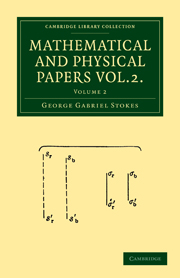Book contents
- Frontmatter
- Contents
- Notes on Hydrodynamics. III. On the Dynamical Equations
- On the constitution of the Luminiferous Ether
- On the Theory of certain Bands seen in the Spectrum
- Notes on Hydrodynamics. IV. Demonstration of a Fundamental Theorem
- On a difficulty in the Theory of Sound
- On the Formation of the Central Spot of Newton's Rings beyond the Critical Angle
- On some points in the Received Theory of Sound
- On the perfect Blackness of the Central Spot in Newton's Rings, and on the Verification of Fresnel's Formula for the intensities of Reflected and Reflacted Rays
- On Attractions, and on Clairaut's Theorem
- On the Variation of Gravity at the Surface of the Earth
- On a Mode of Measuring the Astigmatism of a Defective Eye
- On the Determination of the Wave Length corresponding with any Point of the Spectrum
- Discussion of a Differential Equation relating to the Breaking of Railway Bridges
- Notes on Hydrodynamics, VI. On Waves
- On the Dynamical Theory of Diffraction
- On the Numerical Calculation of a class of Definite Integrals and Infinite Series
- On the Mode of Disappearance of Newton's Rings in passing the Angle of Total Internal Reflection
- On Metallic Reflection
- On a Fictitious Displacement of Fringes of Interference
- On Haidinger's Brushes
- Index
On the Dynamical Theory of Diffraction
Published online by Cambridge University Press: 07 September 2010
- Frontmatter
- Contents
- Notes on Hydrodynamics. III. On the Dynamical Equations
- On the constitution of the Luminiferous Ether
- On the Theory of certain Bands seen in the Spectrum
- Notes on Hydrodynamics. IV. Demonstration of a Fundamental Theorem
- On a difficulty in the Theory of Sound
- On the Formation of the Central Spot of Newton's Rings beyond the Critical Angle
- On some points in the Received Theory of Sound
- On the perfect Blackness of the Central Spot in Newton's Rings, and on the Verification of Fresnel's Formula for the intensities of Reflected and Reflacted Rays
- On Attractions, and on Clairaut's Theorem
- On the Variation of Gravity at the Surface of the Earth
- On a Mode of Measuring the Astigmatism of a Defective Eye
- On the Determination of the Wave Length corresponding with any Point of the Spectrum
- Discussion of a Differential Equation relating to the Breaking of Railway Bridges
- Notes on Hydrodynamics, VI. On Waves
- On the Dynamical Theory of Diffraction
- On the Numerical Calculation of a class of Definite Integrals and Infinite Series
- On the Mode of Disappearance of Newton's Rings in passing the Angle of Total Internal Reflection
- On Metallic Reflection
- On a Fictitious Displacement of Fringes of Interference
- On Haidinger's Brushes
- Index
Summary
When light is incident on a small aperture in a screen, the illumination at any point in front of the screen is determined, on the undulatory theory, in the following manner. The incident waves are conceived to be broken up on arriving at the aperture; each element of the aperture is considered as the centre of an elementary disturbance, which diverges spherically in all directions, with an intensity which does not vary rapidly from one direction to another in the neighbourhood of the normal to the primary wave; and the disturbance at any point is found by taking the aggregate of the disturbances due to all the secondary waves, the phase of vibration of each being retarded by a quantity corresponding to the distance from its centre to the point where the disturbance is sought. The square of the coefficient of vibration is then taken as a measure of the intensity of illumination. Let us consider for a moment the hypotheses on which this process rests. In the first place, it is no hypothesis that we may conceive the waves broken up on arriving at the aperture: it is a necessary consequence of the dynamical principle of the superposition of small motions; and if this principle be inapplicable to light, the undulatory theory is upset from its very foundations.
- Type
- Chapter
- Information
- Mathematical and Physical Papers , pp. 243 - 328Publisher: Cambridge University PressPrint publication year: 2009First published in: 1883
- 3
- Cited by

